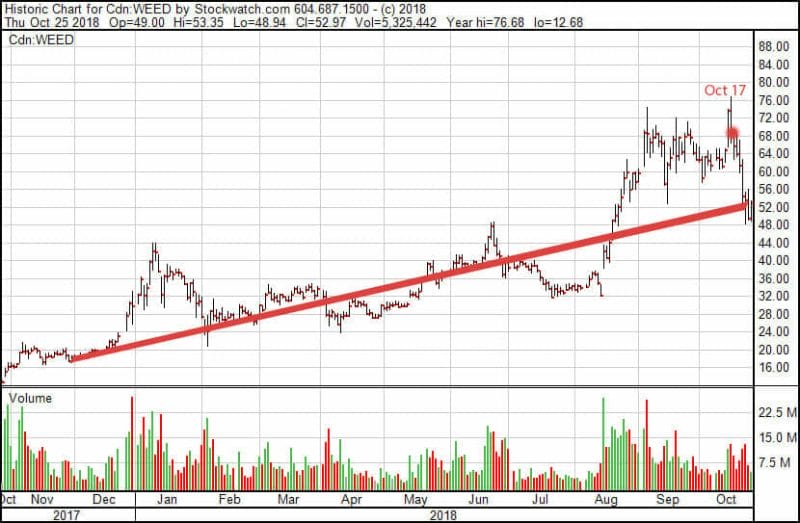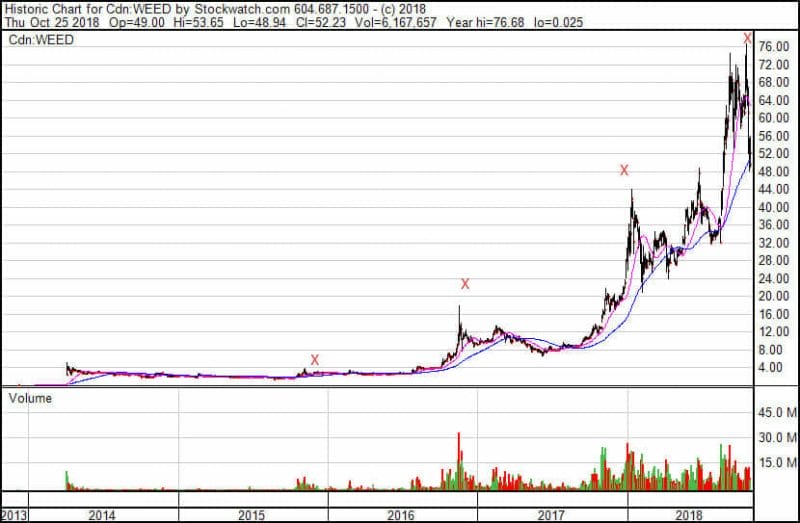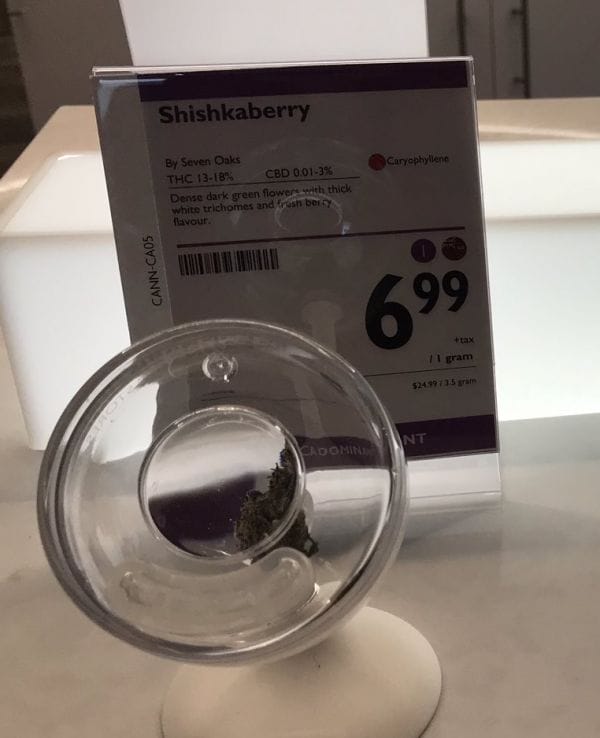I was on a twin prop plane in agricultural Ontario when the markets collapsed. Fellow passengers clamoured for their phones and tried to place sell orders as the axe fell on one company after another.
“Have you seen what’s happening to Aurora?”
“Namaste’s getting killed.”
“Canopy just keeps going down.”
I didn’t take my phone out. I was enjoying some music, and the view, and the only gut churning drops I cared about were the ones where the plane decided an altitude 400 feet lower suited it better than the altitude we’d been cruising at.
Mostly because, with a handful of exceptions that I own because they’re undervalued and/or run by corporate ninjas, I sold my weed stocks a while ago. Almost everything. Which is probably a weird thing for a guy who makes his living writing about weed stocks to say, but here we are.
When the ass fell out of cannabis, I was sleeping happily, knowing that there remained a semblance of order in this chaotic world.
https://equity.guru/2018/10/17/weed-wednesday-canadian-cannabis-legal-mean/
Back in January of last year, I (infamously, at the time) told everyone to sell all their cannabis stocks and be wealthy for a while. I never tell anyone to buy or sell, but this was my big exception to that rule because it was necessary. I did this on stage, several times, and I repeated it in print.
“SELL. FUCKING. EVERYTHING. See what it feels like to have an extra digit on your financial worth. Go back in when it hits bottom.” – Me, at a Cambridge House keynote speech in January.
This was somewhat controversial, partly because I had a dozen weed companies as clients who were enjoying the rise, but I didn’t get one call from a CEO complaining. It was due, and anyone being sensible knew it.
Every cannabis stock had been going to the moon since November 2017 and billions were being minted daily and everyone you talked to was telling you how smart they were because they were in one LP or another, despite the fact the share price of every LP was jumping by a similar amount. If you were in Canopy or Emerald or Matica, you were making as much bank as the next guy. It wasn’t the player, it was the game.
Folks online and in person scoffed at my suggestion that a tripling of everyone’s market cap in the span of a month was probably a point where you should get off the chairlift because, obvs, it was going to continue for the next five years.
And even though, in February, my prediction came true and every weed stock got crushed, I still hear from guys who claim they’re winning because “I bought in at $0.20, so I don’t care that it went from $3 to $1, because it’s $2 now and I’m rich because I’m up 10x!”
Top tip: If you’d sold at $3, you could have tripled your number of shares buying back later at $1, and now you’d be up 30x.
But hey. Well done you for being an average investor.
The reason I felt the market was going to die by February of 2018 was that news was coming. Good news for the sector, sure. Details on more liberal laws, a timeline for full rec, all great stuff that would benefit every company, and folks were buying like mad in the expectation that, when those new rules and the timeline landed, everything would jump like crazy.
But it didn’t. Everything sold off. As I (and many others it should be said) predicted it would.
How did we get it right?
Because there are certain rules that always, predictably, apply to the market.
- A private placement announcement will always see a stock fall, as long holders cash in to buy back at the PP price – with a half warrant attached.
- When pre-listing stock becomes free trading after four months, people will always take their profits, even if the company says they know everybody and it’s ‘in strong hands.’
- Brokers will always try to dissuade new companies from going public until September so they can get in some cabin time in the summer.
- The first company to go public in a brand new sector will have two weeks of fun and then get massacred.
- People buy on rumour, and people sell on news.
That last rule is the one that people ignore most. What it means is, if we know for sure a thing is coming – new weed laws on October 17, for example, or a large, well financed player getting a sales license they’ve been working on for six months, or a merger closing, people buy the stock before that event in the expectation others will be doing likewise.
Then, the day before that predictable news lands, they sell.
They do that because, the next day, everyone else will be selling.
At every stage on the road to cannabis legalization in Canada – every federal court hearing, every legislative move, every sales license granted, there’s a sell off that follows. It ALWAYS happens. It has never not happened. It’s the rules. It’s just fucking science. And you can literally bet on it happening if you’re the kind of player who likes to toss our a short.
Take Supreme Cannabis (FIRE.V): Back in the early days, when they planned to get a grow license, their stock went up pretty hard for a few months – then it lingered as the license failed to show as hoped. It dropped a little, went back a little, but mostly hung about until the day they announced the grow license was in: then the stock dropped hard.
It happened again when the company was waiting for its sales license. It happened again on Weed Wednesday.
Good news days don’t mean good stock jumps, unless that news was NOT expected.
- Company announces it’s switching from blockchain to cannabis (unexpected): Stock prices goes up.
- Company gets its grow license (expected): Stock prices go down.
- Company announces it wants to acquire a competitor (unexpected): Stock prices goes up.
- Company announces it has closed the acquisition (expected): Stock price goes down.
So after February, the market had to prolapse for a while, and boy did it. Some companies got nice and desperate:
https://equity.guru/2018/05/18/namaste-technologies-n-v-will-buy-beer-dont-sell-stock-blown/
Until Canopy attracted beverage interest anyway, which kicked things back into hypermania mode for a bit.
A few months back, things started really roaring again as October 17 loomed and every investor, once again, decided that they were geniuses who knew better than you and that going full rec would see the market take off anew.
“Namaste is going to $17!”
“TGOD has nowhere to go but up!”
“Choom will have 100 stores in three months!”
I mean, god, listen to you people, banging on in your Facebook groups about whatever hometown hero you’re nuthugging with your mortgage payment this month.
“Isodiol is the world’s biggest CBD play!”
“HEXO owns Quebec and will be merged with Coors!”
“Coca-Cola wants Aurora!”
Good grief, it’s depressing. There’s nothing wrong with singing the praises of a company you think is under-appreciated, but the amount of cognitive dissonance out there is insane, even as prices plummet.
As an example, I think Green Organic Dutchman (TGOD.T) is great. I think they’ll do smart things on the consumer packaged goods end of town and will be one day worth way more than they are today, but I’m out of that stock for the most part because, as half the market knows, they have a lot of free trading paper coming available in mid-November.
I don’t think everyone will take their profits, but enough will that the stock will slump.
So I wrote about that. And it duly slumped.
https://equity.guru/2018/10/16/green-organic-dutchman-tgod-t-must-burn-days-order-regrow-bigger-better/
This baffled a lot of people. The folks who throw rocks at me on Twitter, calling me a ‘pumper for sale’, couldn’t figure out why I wasn’t jerking off to the TGOD logo since they pay me for market awareness programs. And the folks who love TGOD couldn’t figure out why I was being so mean to them, since they’re a client.
The answer to both was simple: It’s true. TGOD will face pressure. And then, once that pressure has passed, it’ll be a bona fide bargain.
TGOD IR boss Danny Brody didn’t express dismay at my story at all, in fact he shared it with friends on his Facebook timeline. Nobody at the company complained about it, mostly because nobody at TGOD has ever denied there’ll be a day when folks take their (currently considerable) early investor profits. Heck, they built the company specifically to ensure this day would come and went out of their way to bring small investors into that cycle. Mission hardcore accomplished.
You can be a big fan and be out of the stock. Hell, you should. And that’s why, in July, I ignored the big jump in weed stocks for all but undervalued options. Tilray to $1000? Enjoy the rollercoaster both directions. Canopy to $15b in value? Good luck hunting for a double on that.
But C21 Investments (CXXI.V) acquiring a company with $39m in annual revenues while their market cap was $55m? THAT’S A FREAKIN’ DEAL.
GTEC Holdings (GTEC.C) sitting on a $67m market cap with six (or is it seven, they keep adding) 100% owned cannabis properties at various stages of licensing, including one cultivation license, with a full lab, extraction facility, dealer’s license and retail arm – for $67m in market cap? Yeah, I’ll hold that, thanks.
Pure Global (PURE.V) with, frankly, anything above a car trunk full of weed AND a $35m market cap? Jesus. They could sneeze and be a double. In.
You may well be sitting on your Canopy stock right now and be white knuckling it, hoping for a quick comeback to where it had been. And maybe one day that’ll happen.
But here’s what we know:
Canopy has been a great bellwether stock for the cannabis sector, because the biggest guy leads the shifts for the little guys.
And as you can see, with the exception of those two ‘buy the rumour, sell the news’ periods, where things ran hard for a month leading up to a big date and then cratered, Canopy has been a pretty steady slow builder. Sure, it’s down from over $76 to $52 in just a few days, but it’s also up from $17 top $52 in under a year, and up from $32 to $52 in under three months. If we ignore the outlier events, that’s a nice little earner, market correction be damned.
And if we overlay just about any other LP on this chart, they’re pretty similar in scope, if not size.
Here’s another chart to note:
Notice each of the red X’s on that Canopy five year price chart. They indicate a massive rise, and a fairly quick significant fall off soon after.
The scale of the most recent run-ups obscures the ‘everything doubled’ jump from late 2015, but 2016, 2017, and 2018 have been pretty damn pronounced. Every year, as Christmas comes, weed goes ballistic. And every year, we say ‘it’s not justifiable’ until it is.
Now, we’ve either just gone through the 2018 version of that, in which case we’re due for a few months of dust settling, or we’re not through that yet and we’re going to see a stiff turnaround soon.
My thinking is, we’re somewhere in the middle. The market needed to get back to sensible, and some big institutional guys are looking for those leaders to justify their market caps. Business – real business – needs to be done. There’s no longer a distant legalization date to point to as the industry’s nirvana, now it’s down to sales numbers.
And, for the big guys? That’s FUCT.
In Canada, the system as it stands right now puts every producer at the same level in the government distribution model. A tiny $5m producer will sit next to multi-billion-dollar Canopy on the shelf, and both will be in plain paper packaging with minimal marketing info and with, essentially, no consumer goodwill. They get the same weight on the ecommerce sites, they’re going to have similar early sales numbers, and a lot of companies will boast of sales without considering they a lot of those sales happened because other suppliers were out of stock and they fell next in the list.
In the US, here’s what Rubicon Organics (ROMJ.C) products look like. They’re amazing, and a great differentiator. The artist series labeling is majestic.
But, in Canada, Rubicon has to go plain paper, one small logo, a fat warning, and no real helpful info about what your’e consuming. In BC stores, you don’t even get a logo, just a fat fonted price and THC levels, and an ID number that’s bigger than the name of the supplier.
If this anti-marketing regulatory sentiment was different, I’d be buying Canopy stock right now because they’d be able to buy TV ads and billboards, and use crazy NY based design firms for adventurous logos and bright packaging, and give away t-shirts, and have samplings at Costco where old Chinese women line up five times in a row until their handbag is filled with microwaveable bacon wraps, soy yogurt snacks, and Shishkaberry weed.
But that’s not our world. Our world is, you buy what’s cheap, you buy a little of it in case it sucks, and you don’t give even a little bit of a shit as to what company grew it because, let’s face it, you don’t really want to smoke the stuff as much as you’d love to eat a cookie, but cookies aren’t allowed so RAAARGHRGAH!
And all of this is making it hard to do actual business, and really hard to do the sort of high volume business you need to do to help cover the electricity bill in a greenhouse in Edmonton in the winter:
By the end of the fifth day, the [Societe Quebecoise du Cannabis] reported a steady, almost daily decline in marijuana sales.
With over 30,000 online transactions on the first day, the numbers dropped off to a mere 2910 by Sunday. – [link]
https://equity.guru/2018/10/24/canada-found-recreational-cannabis-shortage-just-days-legalization/
This warrants a substantial expectation reset. Can Canopy sell enough weed in this system, as it is currently, to justify even a half billion dollar market cap, or do they have to wait until everyone else is sold out to make real use of their size?
Who will hold their early customers, when they’ve had a chance to try a gram of everything? What percentage of customers know a good gram from an Aphria gram? Which company will be the first to game the system, and divide one strain into several SKUs, so they have more appearances on government cannabis websites and sell quicker?
“Try Shishkaberry Basic for a nice buzz, Shishkaberry Gold for that ‘gettin it on’ tremble, and Shiskaberry Platinum with gingko biloba for when you really want to just kidding, they’re all the same.”
Will the bigger players be forced to lobby hard for relaxation of current rules, or will they look overseas for where they can actually do profitable business? Will the separation between Canada and the US stand, or will the walls begin to crumble, as we’ve seen recently by TGOD using a venture arm to invest in, and take public, US-based Plus Products?
Hell, I don’t know what the future holds. It appears nobody does:
But I know this: If the sales numbers we’re seeing in Canada hold, nobody has an advantage of size. Which means the little market caps are IN PLAY and the big boys are going to have to think fast.
https://equity.guru/2018/10/19/professional-cannabis-players-discounted-theyre-actually-building-businesses/
— Chris Parry
–FULL DISCLOSURE: Rubicon Organics, TGOD, Isodiol, Choom, Pure, C21 Investments, Supreme Cannabis, and GTEC are Equity.Guru marketing clients







Just a quick update, QC had a decline in MJ sales not because of a decrease in demand but because of a shortage of inventory – They sold out. Take a look on the SQDC site yourself, all that’s left is the really expenisve stuff in 10g tubs.
https://montrealgazette.com/news/local-news/cannabis-shortage-could-be-downfall-of-retail-network-sqdc-worries
Growing up in QC I can tell you the demand here is very real, at least 50% of all the people I know smoke pot (and I’m in my late 30’s, the number of MJ users increases as you go down in age). Unfortunately our Govt. was too stupid to anticipate the demand and we have shortages, they also do not allow private dispensaries so “Pablo” on the corner will still be in business for the time being.
But the rest of your article is spot on,